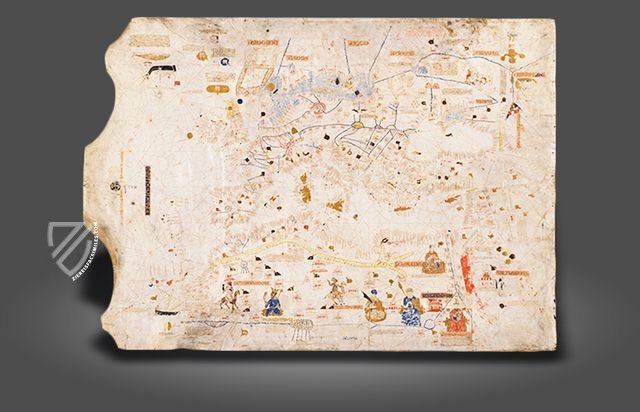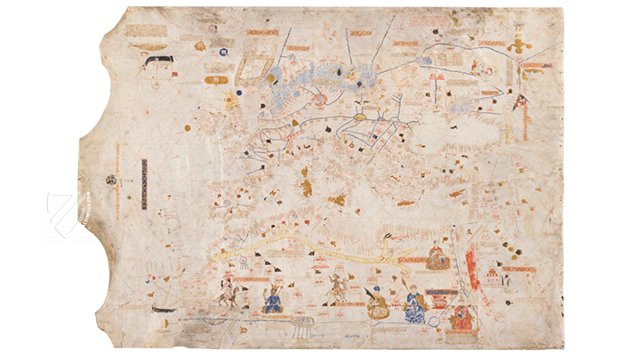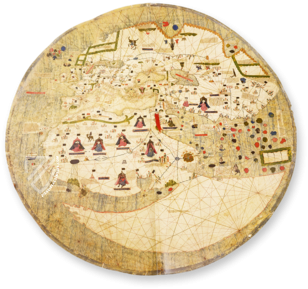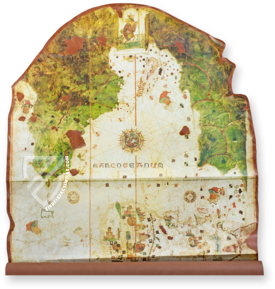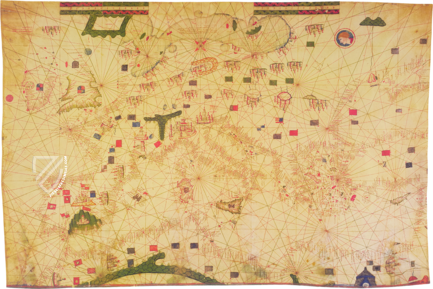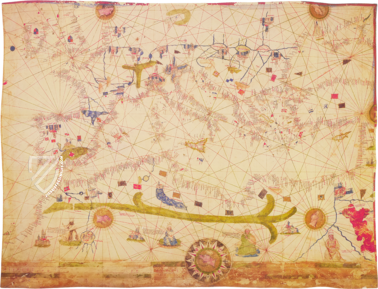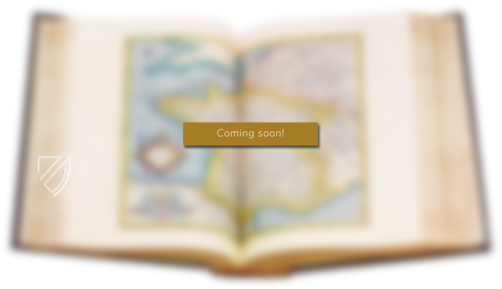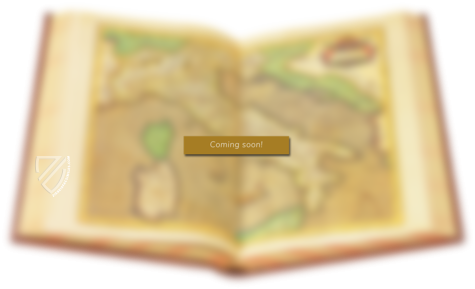Nautical Chart by Mecia de Viladestes
(1,000€ - 3,000€)
The Majorcan school of cartography produced some of the most important practitioners of their trade in the Late Middle Ages. One of the most important, Mecia de Viladestes, completed a sea chart that set new standards of cartography in 1413. Of particular importance for the famous sea chart by Mecia de Viladestes is the depiction of the Sahara. The Spanish cartographer was one of the few insiders who knew the mysterious routes of the gold merchants through the dangerous African desert. In addition, Mecia de Viladestes depicted several unknown islands and exceptional scenes in his groundbreaking map. The sea chart of Mecia de Viladestes is of exceptional significance for the history of cartography!
Map of Mecia de Viladestes
The Majorcan school of cartography produced some of the most important practitioners of their trade in the Late Middle Ages. One of the most important, Mecia de Viladestes, completed a sea chart that set new standards of cartography in 1413. Of particular importance for the famous sea chart by Mecia de Viladestes is the depiction of the Sahara. The Spanish cartographer was one of the few insiders who knew the mysterious routes of the gold merchants through the dangerous African desert. In addition, Mecia de Viladestes depicted several unknown islands and exceptional scenes in his groundbreaking map. The sea chart of Mecia de Viladestes is of exceptional significance for the history of cartography!
An Important Cartographer
Meccia de Viladeste was a Jewish cartographer in Spain who, like many others, converted to Christianity and undertook numerous research expeditions at the behest of the King of Aragon. He was ascribed to the so-called Majorcan school of cartography, which was predominant from the 13th to the 15th centuries and which produced a masterpiece of European cartography with the famous Catalan Atlas of 1375 by Cresques Abraham. This Catalan World Atlas, made for King Peter IV of Aragon, was gifted to the French King Charles V in 1380, which is why it is housed in the French National Library today. As a groundbreaking cartographic document, the sea chart of Mecia de Viladestes is no less significant.
An Artistic Highlight Too!
The map on vellum measures 115 x 85 cm and is dated 1413. It shows a region, which encompasses the northeast Atlantic, the Mediterranean, the Black and Red Seas, as well as a part of the Persian Gulf, the Caspian Sea, and Baltic Sea. Wonderful illustrations supplement the numerous Catalonian descriptions that cover the portolan chart. Alongside cities and oases, watering holes and mountains, Africa is especially adorned with representations of camels, dark-skinned people, and four splendidly dressed African kings. Finally, the figure of John the Baptist kneels in the Nile Delta.
The River of Gold Through Africa
The fascination with Africa that already existed at the beginning of the 15th century is visualized by the map of Mecia de Viladestes. In Viladestes’ map, Africa stretches from West to East along the great rivers: the Senegal, Niger, and Niles. Caravans march through the desert to trade salt for gold with the desert tribes. This lucrative business was negotiated along top secret routes straight through the desert, which were only know to a few insiders. Viladestes knew these strictly secret locations in the desert where the caravans traded gold for salt. On the lower margin of his map, Viladestes attached explanations for the stages of the journey through the Sahara.
The North of the Seas
This exceptionally detailed information about the African continent was appended by an additional special feature of Viladestes’ sea chart. The Majorcan cartographer also depicted the northern regions of the Atlantic, whereof no maps were known in spite of the Hanseatic League. Viladestes integrated a wonderfully figurative scene there. Near Iceland, a small boat, having been unloaded from a large ship, nears an imposing whale in order to slay him with a harpoon. Upon closer inspection, a bishop can be recognized onboard the ship. This depiction could be of the legend of St. Brendan and thus interlinks religious legends with the reality of whaling.
Unknown Islands?
Mecia de Viladestes paid close attention to the islands in the Atlantic, which are depicted with great care and detail. There Viladestes distinguishes himself as an exceptional cartographer with the constant drive after the actualization of his knowledge in this time of great discoveries. He depicted several small islands at the river-mouth of the great African stream of gold. These were interpreted as the Cape Verde Islands, which were nevertheless first officially discovered in 1455. As a result, the sea chart of Mecia de Viladestes circumscribes the history of discovery! The sea chart of Mecia de Viladestes enchants in its entirety and in connecting with this variety of innovative notations. It is one of the most important maps from the famous and well known collection of the Bibliothèque Nationale de France.
Codicology
- Alternative Titles
- Carta Naútica de Mecia de Viladestes
Portulan de Mecia de Viladestes
Seekarte des Mecia de Viladestes
Meciá de Viladestes' Nautical Chart - Type
- Map on parchment
- Size / Format
- 1 map / 115.0 × 85.0 cm
- Origin
- Spain
- Date
- 1413
- Epochs
- Style
- Genre
- Artist / School
- Mecia (Matthew) de Viladestes
- Previous Owners
- Convent of Val de Cristo
#1 Carta Naútica de Mecia de Viladestes
(1,000€ - 3,000€)
- Treatises / Secular Books
- Apocalypses / Beatus
- Astronomy / Astrology
- Bestiaries
- Bibles / Gospels
- Chronicles / History / Law
- Geography / Maps
- Saints' Lives
- Islam / Oriental
- Judaism / Hebrew
- Single Leaf Collections
- Leonardo da Vinci
- Literature / Poetry
- Liturgical Manuscripts
- Medicine / Botany / Alchemy
- Music
- Mythology / Prophecies
- Psalters
- Other Religious Books
- Games / Hunting
- Private Devotion Books
- Other Genres
- Afghanistan
- Armenia
- Austria
- Belgium
- Belize
- Bosnia and Herzegovina
- China
- Colombia
- Costa Rica
- Croatia
- Cyprus
- Czech Republic
- Denmark
- Egypt
- El Salvador
- Ethiopia
- France
- Germany
- Greece
- Guatemala
- Honduras
- Hungary
- India
- Iran
- Iraq
- Israel
- Italy
- Japan
- Jordan
- Kazakhstan
- Kyrgyzstan
- Lebanon
- Liechtenstein
- Luxembourg
- Mexico
- Morocco
- Netherlands
- Palestine
- Panama
- Peru
- Poland
- Portugal
- Romania
- Russia
- Serbia
- Spain
- Sri Lanka
- Sweden
- Switzerland
- Syria
- Tajikistan
- Turkey
- Turkmenistan
- Ukraine
- United Kingdom
- United States
- Uzbekistan
- Vatican City
- A. Oosthoek, van Holkema & Warendorf
- Aboca Museum
- Ajuntament de Valencia
- Akademie Verlag
- Akademische Druck- u. Verlagsanstalt (ADEVA)
- Aldo Ausilio Editore - Bottega d’Erasmo
- Alecto Historical Editions
- Alkuin Verlag
- Almqvist & Wiksell
- Amilcare Pizzi
- Andreas & Andreas Verlagsbuchhandlung
- Archa 90
- Archiv Verlag
- Archivi Edizioni
- Arnold Verlag
- ARS
- Ars Magna
- ArtCodex
- AyN Ediciones
- Azimuth Editions
- Badenia Verlag
- Bärenreiter-Verlag
- Belser Verlag
- Belser Verlag / WK Wertkontor
- Benziger Verlag
- Bernardinum Wydawnictwo
- BiblioGemma
- Biblioteca Apostolica Vaticana (Vaticanstadt, Vaticanstadt)
- Bibliotheca Palatina Faksimile Verlag
- Bibliotheca Rara
- Boydell & Brewer
- Bramante Edizioni
- Bredius Genootschap
- Brepols Publishers
- British Library
- C. Weckesser
- Caixa Catalunya
- Canesi
- CAPSA, Ars Scriptoria
- Caratzas Brothers, Publishers
- Carus Verlag
- Casamassima Libri
- Centrum Cartographie Verlag GmbH
- Chavane Verlag
- Christian Brandstätter Verlag
- Circulo Cientifico
- Club Bibliófilo Versol
- Club du Livre
- CM Editores
- Collegium Graphicum
- Collezione Apocrifa Da Vinci
- Comissão Nacional para as Comemorações dos Descobrimentos Portugueses
- Coron Verlag
- Corvina
- CTHS
- D. S. Brewer
- Damon
- De Agostini/UTET
- De Nederlandsche Boekhandel
- De Schutter
- Deuschle & Stemmle
- Deutscher Verlag für Kunstwissenschaft
- DIAMM
- Droz
- E. Schreiber Graphische Kunstanstalten
- Ediciones Boreal
- Ediciones Grial
- Ediclube
- Edições Inapa
- Edilan
- Editalia
- Edition Deuschle
- Edition Georg Popp
- Edition Leipzig
- Edition Libri Illustri
- Editiones Reales Sitios S. L.
- Éditions de l'Oiseau Lyre
- Editions Medicina Rara
- Editorial Casariego
- Editorial Mintzoa
- Editrice Antenore
- Editrice Velar
- Edizioni Edison
- Egeria, S.L.
- Eikon Editores
- Electa
- Emery Walker Limited
- Enciclopèdia Catalana
- Eos-Verlag
- Ephesus Publishing
- Ernst Battenberg
- Eugrammia Press
- Extraordinary Editions
- Fackelverlag
- Facsimila Art & Edition
- Facsimile Editions Ltd.
- Facsimilia Art & Edition Ebert KG
- Faksimile Verlag
- Feuermann Verlag
- Folger Shakespeare Library
- Franco Cosimo Panini Editore
- Friedrich Wittig Verlag
- Fundación Hullera Vasco-Leonesa
- G. Braziller
- Gabriele Mazzotta Editore
- Gebr. Mann Verlag
- Gesellschaft für graphische Industrie
- Getty Research Institute
- Giovanni Domenico de Rossi
- Giunti Editore
- Graffiti
- Grafica European Center of Fine Arts
- Guido Pressler
- Guillermo Blazquez
- Gustav Kiepenheuer
- H. N. Abrams
- Harrassowitz
- Harvard University Press
- Helikon
- Hendrickson Publishers
- Henning Oppermann
- Herder Verlag
- Hes & De Graaf Publishers
- Hoepli
- Holbein-Verlag
- Houghton Library
- Hugo Schmidt Verlag
- Idion Verlag
- Il Bulino, edizioni d'arte
- ILte
- Imago
- Insel Verlag
- Insel-Verlag Anton Kippenberger
- Instituto de Estudios Altoaragoneses
- Instituto Nacional de Antropología e Historia
- Introligatornia Budnik Jerzy
- Istituto dell'Enciclopedia Italiana - Treccani
- Istituto Ellenico di Studi Bizantini e Postbizantini
- Istituto Geografico De Agostini
- Istituto Poligrafico e Zecca dello Stato
- Italarte Art Establishments
- Jan Thorbecke Verlag
- Johnson Reprint Corporation
- Josef Stocker
- Josef Stocker-Schmid
- Jugoslavija
- Karl W. Hiersemann
- Kasper Straube
- Kaydeda Ediciones
- Kindler Verlag / Coron Verlag
- Kodansha International Ltd.
- Konrad Kölbl Verlag
- Kurt Wolff Verlag
- La Liberia dello Stato
- La Linea Editrice
- La Meta Editore
- Lambert Schneider
- Landeskreditbank Baden-Württemberg
- Leo S. Olschki
- Les Incunables
- Liber Artis
- Library of Congress
- Libreria Musicale Italiana
- Lichtdruck
- Lito Immagine Editore
- Lumen Artis
- Lund Humphries
- M. Moleiro Editor
- Maison des Sciences de l'homme et de la société de Poitiers
- Manuscriptum
- Martinus Nijhoff
- Maruzen-Yushodo Co. Ltd.
- MASA
- Massada Publishers
- McGraw-Hill
- Metropolitan Museum of Art
- Militos
- Millennium Liber
- Müller & Schindler
- Nahar - Stavit
- Nahar and Steimatzky
- National Library of Wales
- Neri Pozza
- Nova Charta
- Oceanum Verlag
- Odeon
- Orbis Mediaevalis
- Orbis Pictus
- Österreichische Staatsdruckerei
- Oxford University Press
- Pageant Books
- Parzellers Buchverlag
- Patrimonio Ediciones
- Pattloch Verlag
- PIAF
- Pieper Verlag
- Plon-Nourrit et cie
- Poligrafiche Bolis
- Presses Universitaires de Strasbourg
- Prestel Verlag
- Princeton University Press
- Prisma Verlag
- Priuli & Verlucca, editori
- Pro Sport Verlag
- Propyläen Verlag
- Pytheas Books
- Quaternio Verlag Luzern
- Reales Sitios
- Recht-Verlag
- Reichert Verlag
- Reichsdruckerei
- Reprint Verlag
- Riehn & Reusch
- Roberto Vattori Editore
- Rosenkilde and Bagger
- Roxburghe Club
- Salerno Editrice
- Saltellus Press
- Sandoz
- Sarajevo Svjetlost
- Schöck ArtPrint Kft.
- Schulsinger Brothers
- Scolar Press
- Scrinium
- Scripta Maneant
- Scriptorium
- Shazar
- Siloé, arte y bibliofilia
- SISMEL - Edizioni del Galluzzo
- Sociedad Mexicana de Antropología
- Société des Bibliophiles & Iconophiles de Belgique
- Soncin Publishing
- Sorli Ediciones
- Stainer and Bell
- Studer
- Styria Verlag
- Sumptibus Pragopress
- Szegedi Tudomànyegyetem
- Taberna Libraria
- Tarshish Books
- Taschen
- Tempus Libri
- Testimonio Compañía Editorial
- Thames and Hudson
- The Clear Vue Publishing Partnership Limited
- The Facsimile Codex
- The Folio Society
- The Marquess of Normanby
- The Richard III and Yorkist History Trust
- Tip.Le.Co
- TouchArt
- TREC Publishing House
- TRI Publishing Co.
- Trident Editore
- Tuliba Collection
- Typis Regiae Officinae Polygraphicae
- Union Verlag Berlin
- Universidad de Granada
- University of California Press
- University of Chicago Press
- Urs Graf
- Vallecchi
- Van Wijnen
- VCH, Acta Humaniora
- VDI Verlag
- VEB Deutscher Verlag für Musik
- Verlag Anton Pustet / Andreas Verlag
- Verlag Bibliophile Drucke Josef Stocker
- Verlag der Münchner Drucke
- Verlag für Regionalgeschichte
- Verlag Styria
- Vicent Garcia Editores
- W. Turnowski Ltd.
- W. Turnowsky
- Waanders Printers
- Wiener Mechitharisten-Congregation (Wien, Österreich)
- Wissenschaftliche Buchgesellschaft
- Wissenschaftliche Verlagsgesellschaft
- Wydawnictwo Dolnoslaskie
- Xuntanza Editorial
- Zakład Narodowy
- Zollikofer AG

